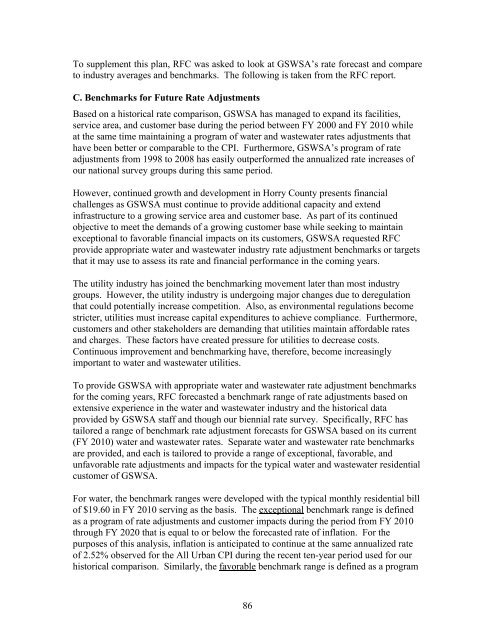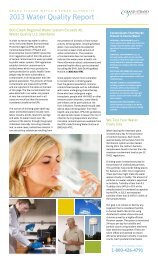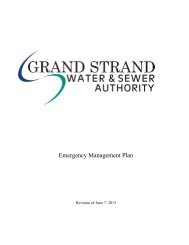2030 Plan - Grand Strand Water and Sewer Authority
2030 Plan - Grand Strand Water and Sewer Authority
2030 Plan - Grand Strand Water and Sewer Authority
Create successful ePaper yourself
Turn your PDF publications into a flip-book with our unique Google optimized e-Paper software.
To supplement this plan, RFC was asked to look at GSWSA’s rate forecast <strong>and</strong> compare<br />
to industry averages <strong>and</strong> benchmarks. The following is taken from the RFC report.<br />
C. Benchmarks for Future Rate Adjustments<br />
Based on a historical rate comparison, GSWSA has managed to exp<strong>and</strong> its facilities,<br />
service area, <strong>and</strong> customer base during the period between FY 2000 <strong>and</strong> FY 2010 while<br />
at the same time maintaining a program of water <strong>and</strong> wastewater rates adjustments that<br />
have been better or comparable to the CPI. Furthermore, GSWSA’s program of rate<br />
adjustments from 1998 to 2008 has easily outperformed the annualized rate increases of<br />
our national survey groups during this same period.<br />
However, continued growth <strong>and</strong> development in Horry County presents financial<br />
challenges as GSWSA must continue to provide additional capacity <strong>and</strong> extend<br />
infrastructure to a growing service area <strong>and</strong> customer base. As part of its continued<br />
objective to meet the dem<strong>and</strong>s of a growing customer base while seeking to maintain<br />
exceptional to favorable financial impacts on its customers, GSWSA requested RFC<br />
provide appropriate water <strong>and</strong> wastewater industry rate adjustment benchmarks or targets<br />
that it may use to assess its rate <strong>and</strong> financial performance in the coming years.<br />
The utility industry has joined the benchmarking movement later than most industry<br />
groups. However, the utility industry is undergoing major changes due to deregulation<br />
that could potentially increase competition. Also, as environmental regulations become<br />
stricter, utilities must increase capital expenditures to achieve compliance. Furthermore,<br />
customers <strong>and</strong> other stakeholders are dem<strong>and</strong>ing that utilities maintain affordable rates<br />
<strong>and</strong> charges. These factors have created pressure for utilities to decrease costs.<br />
Continuous improvement <strong>and</strong> benchmarking have, therefore, become increasingly<br />
important to water <strong>and</strong> wastewater utilities.<br />
To provide GSWSA with appropriate water <strong>and</strong> wastewater rate adjustment benchmarks<br />
for the coming years, RFC forecasted a benchmark range of rate adjustments based on<br />
extensive experience in the water <strong>and</strong> wastewater industry <strong>and</strong> the historical data<br />
provided by GSWSA staff <strong>and</strong> though our biennial rate survey. Specifically, RFC has<br />
tailored a range of benchmark rate adjustment forecasts for GSWSA based on its current<br />
(FY 2010) water <strong>and</strong> wastewater rates. Separate water <strong>and</strong> wastewater rate benchmarks<br />
are provided, <strong>and</strong> each is tailored to provide a range of exceptional, favorable, <strong>and</strong><br />
unfavorable rate adjustments <strong>and</strong> impacts for the typical water <strong>and</strong> wastewater residential<br />
customer of GSWSA.<br />
For water, the benchmark ranges were developed with the typical monthly residential bill<br />
of $19.60 in FY 2010 serving as the basis. The exceptional benchmark range is defined<br />
as a program of rate adjustments <strong>and</strong> customer impacts during the period from FY 2010<br />
through FY 2020 that is equal to or below the forecasted rate of inflation. For the<br />
purposes of this analysis, inflation is anticipated to continue at the same annualized rate<br />
of 2.52% observed for the All Urban CPI during the recent ten-year period used for our<br />
historical comparison. Similarly, the favorable benchmark range is defined as a program<br />
86






